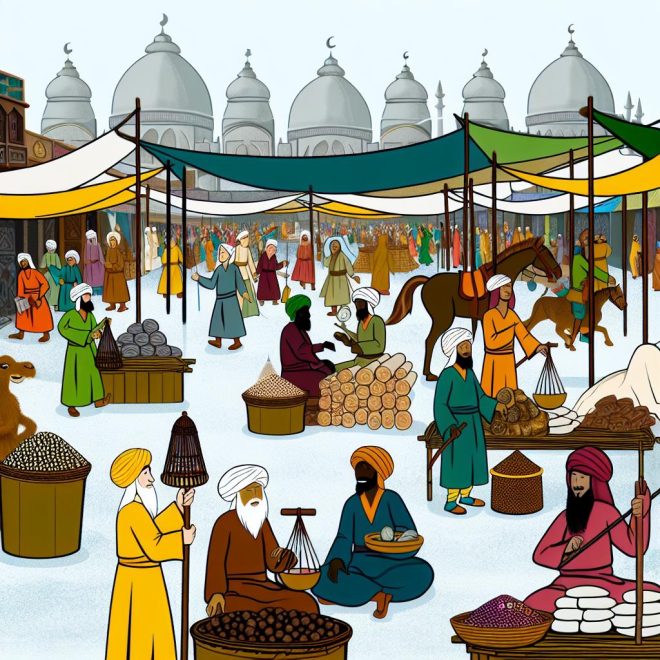The Spread of Buddhism Along the Silk Road
The Silk Road stands as a remarkable historical network of trade routes that interlinked the East and West, fostering not merely the exchange of goods but also serving as a conduit for ideas, culture, and religions. One of the most transformative cultural interactions facilitated by the Silk Road was the dissemination of Buddhism. This religious movement significantly influenced both commercial activities and economic structures during its spread.
Buddhism’s Journey Along the Silk Road
Buddhism had its genesis in India. Over the centuries, it made its way north into Central Asia and further into China, traveling along the trade routes of the Silk Road. This migration was propelled by monks, pilgrims, and traders who carried with them Buddhist texts and artifacts, sowing the seeds of Buddhism in diverse lands. As these individuals moved, they set up monastic communities, which evolved into centers of scholarly pursuit and cultural interchange in urban settlements along the Silk Road.
Buddhist monks played a crucial role, acting as both spiritual and cultural emissaries. They not only shared teachings of Buddhism but also brought with them aspects of Indian culture and language, which intermingled with the local customs and traditions they encountered. As these teachings took root, local adaptations of Buddhism emerged, reflecting the unique cultural context of each region along the Silk Road.
Impact on Trade
The dissemination of Buddhism was pivotal in boosting commerce along the Silk Road. Buddhist monasteries and communities functioned as rest stops and sanctuaries for merchants and travelers. They offered essential services such as lodging, food, and security, incentivizing more traders to undertake long journeys. This created a ripple effect that amplified trading activities across the regions.
The influence of Buddhist teachings, particularly the principle of non-violence and compassion towards all beings, fostered an environment of relative harmony among the diverse ethnicities and cultures that the Silk Road connected. Such peaceful coexistence proved crucial for trade, as it diminished ethnic conflicts and engendered trust among merchants from disparate regions. Trust is the bedrock of trade, and Buddhism undoubtedly contributed to a more stable trading environment.
Buddhist Art and Culture as Trade Commodities
With the spread of Buddhism came an increased demand for Buddhist art and cultural products. Sculptures depicting the Buddha, religious artifacts, and sacred texts emerged as highly sought-after commodities. The production and trade of these items not only stimulated local economies but also spawned new market niches for artisans and traders who specialized in these unique goods.
Craftsmen along the Silk Road began to produce intricately designed Buddhist icons, employing locally available materials and techniques. This blending of Buddhist themes with indigenous art styles birthed a diverse range of artistic expressions, further enriching the cultural tapestry of the regions.
Economic Transformation
The propagation of Buddhism along the Silk Road catalyzed substantial economic transformations. As monasteries and religious institutions were established, they often spurred the development of new urban centers. These burgeoning hubs attracted an influx of merchants, artisans, and craftspeople. The resultant economic growth was accompanied by a diversification of local economic activity.
Often strategically located, these urban centers served as crucial junctions for trade, linking distant regions with the wealth of goods, ideas, and practices they offered. The multicultural interactions facilitated by these centers played a pivotal role in the Silk Road’s continued vitality as a thoroughfare of economic and cultural exchange.
The Role of Monasteries
Monasteries themselves grew into powerful economic entities, amassing significant wealth through donations, land grants, and the shrewd management of agricultural domains. The wealth accrued allowed monasteries to actively engage in trade and commerce, weaving them into the fabric of the Silk Road’s economic system.
In addition to their spiritual and educational roles, these monasteries often provided banking and lending services, making them indispensable to local economies. Many became centers of technological and scientific innovation, contributing to agriculture, construction, and craft, which further reinforced their economic standing and influence within society.
Conclusion
In summation, the spread of Buddhism along the Silk Road was instrumental in molding trade and economic structures between the East and the West. The profound religious, cultural, and economic exchanges fostered by Buddhism cultivated a vibrant environment that nurtured growth and innovation throughout the regions connected by this ancient network. The enduring legacy of these exchanges underscores the pivotal role played by religion in sculpting the economic and cultural landscapes of history.
The story of Buddhism along the Silk Road serves as a testament to how spiritual movements can transcend their origins, influencing not only the spiritual landscape but also the material and cultural aspects of the regions they touch. This rich interplay between commerce and spirituality along the Silk Road continues to be a subject of fascination and study, offering valuable insights into the mechanisms of cultural diffusion and economic integration.
